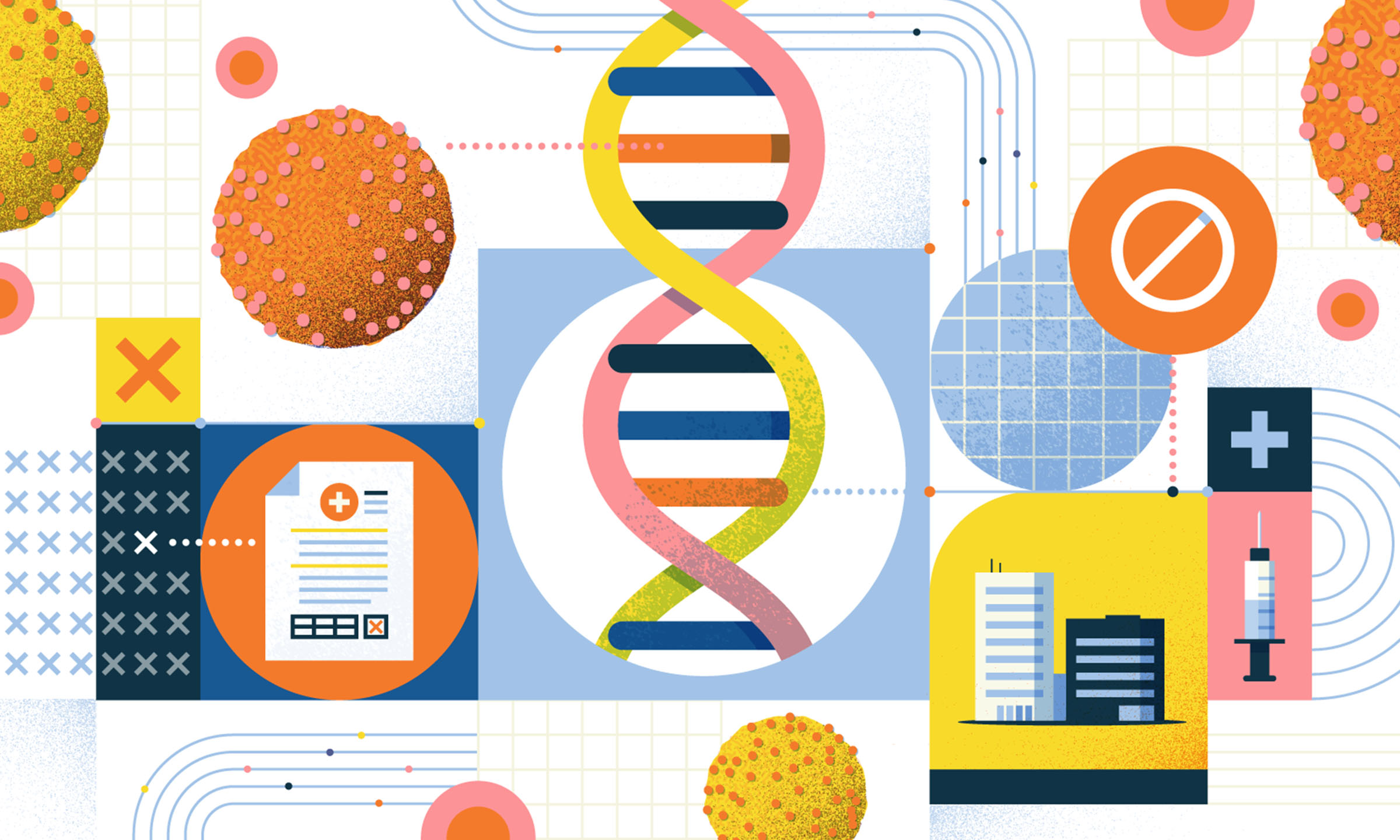The Complex Spiral of Oncology Medication Prior Authorization
With oncology medication prior authorizations, the stakes are higher, the data burden is heavier and the consequences of a denial have great impact. More efficient processes, aided by technology and human intervention, could help both care teams and payers get patients on care plans sooner, to promote better outcomes.

Cancer care is complex, and cancer medication prior authorization (PA) is no exception. Cancer treatments aren’t usually silver bullets. They’re often one part of an extensive care plan, with each piece dependent on another to move patient health forward, like intertwined gears.
Even with the right pieces in place, PA requirements can upend or delay the entire plan. When asked about challenging PA pain points to address, 65% of oncologists listed turnaround time as a top priority.CoverMyMeds Oncology Provider Survey, 2022
These challenges can present physically in patients, too. Twenty-six percent self-reported worsening symptoms and 18% self-reported progression of their disease due to treatment delays.CoverMyMeds Oncology Patient Survey, 2022
In this article, we’ll review the unique challenges associated with the oncology PA process and identify opportunities for improvements to help patients start therapy sooner.
Complicated prior authorization processes can delay the entirety of a patient's treatment plan as opposed to just that particular drug.
Joshua CoxPharm.D., Dayton Physician's Network
Each treatment is part of a bigger plan
With PA, oncology drugs are unique — even among specialty medications — as they are time sensitive and part of a bigger care plan that requires a lot of coordination.
Joshua Cox, Pharm.D., would know. As the director of pharmacy and research at the Dayton Physician’s Network, a community oncology group, Cox helps navigate unique care plans for more than 40,000 patients each year.
“The drugs can be combined with other drugs or therapies such as radiation, and it's critical that the medications follow a certain sequence to be as effective as possible,” he said. “So complicated prior authorization processes can delay the entirety of a patient's treatment plan as opposed to just that particular drug.”
Some studies estimate cancer patients take an average of five prescription medications as part of their treatment plan.Use of Prescription and Non-Prescription Medications and Supplements by Cancer Patients during Chemotherapy; Questionnaire Validation, Hanigan et.al., 2009 Each of these can come with its own side effects and requirements, both clinical and administrative in nature.

Developing a patient’s care plan can be a meticulous process, and getting it approved for coverage can take creativity and coordination as well. Providers and their care teams must be educated in how to submit care plans to patients’ insurance companies, ensuring nothing is forgotten, is written in error or needs a dosage change. Otherwise, the entire plan must be approved again.
This process of precision benefits greatly from real-time updates and communication among providers, pharmacists and payers.
Jennifer Simmons, Pharm.D., a pharmacist with the Dayton Physician’s Network, said their team receives PA requirement notifications in real time through their dispensing software.
Then the real work begins: gathering research, consulting National Comprehensive Cancer Network (NCCN) guidelines, pharmacologic data and even conducting peer-to-peer reviews, where the prescribing oncologist speaks with a clinician at the insurance company about the reasons for prescribing a particular drug. Eighty-one percent of oncologists surveyed listed peer-to-peer review as an important PA pain point to address.1
Once the team submits evidence to address the PA request, the manual processes continue, as pharmacists and the care team run claims daily until they receive an approved or denied notification.
“It might be beneficial to have some sort of automated notification system so you wouldn't have to constantly run test claims to find out if a PA has gone through,” Simmons said.
The dual-benefit balance: pharmacy or medical
Care teams could also benefit from technology-assisted PA efficiencies for managing different benefit types.
Nearly half of newly launched oncology medications are taken orally, which typically means they’re covered under a patient’s pharmacy benefit.Global Oncology Trends, IQVIA, 2022
Other medications, such as infusions or injectables administered at a clinical site, are usually covered under a patient’s medical benefit.Health Plans’ Coverage Of Some Drugs Can Be A Source Of Consumer Confusion, Kaiser Health Network, 2015
What’s more, medical benefit drug coverage can vary down to the individual plan and, if commercial, group level. This can turn PA request submissions into form-finding missions, with care teams scouring payer websites and portals and spending hours on the phone.
It bears repeating: This could be happening while care teams are trying to get another drug in the same patient’s care plan approved through pharmacy benefit.
Simmons said when oral drugs are denied with no other oral alternatives, patients are then usually prescribed infusion therapy, covered under medical benefit.
“The infusion medication is going to end up being significantly more expensive, many times more toxic and really just ends up driving up total cost of care,” she said. “But we have this firewall in the insurance industry between the medical and prescription benefit. … It's a loss for the healthcare system, it's a loss for the patient.”
Simmons said their office splits the work between pharmacy and medical PA teams, and communication between the two can be critical — especially if one medication is ultimately denied. Additionally, Cox noted this happens multiple times per day in their practice.
“If one is denied, we have to go back to the drawing board but, more importantly, the therapy is delayed,” he said.
A recent study found 72% of oral anticancer medications require PA.Association between insurance plan, prior authorization, and time to receipt of oral anticancer drugs, Lichtenstein, 2021Patients in the study waited a median of one week to start therapy and 25% waited two weeks due to PA-related delays.Association between insurance plan, prior authorization, and time to receipt of oral anticancer drugs, Lichtenstein, 2021
With a life on the line, time is of the essence
Oncology care teams trying to justify a prescribed treatment may at times feel like they’re writing a thesis paper again. Necessary documentation for PA approval can include evidence from NCCN guidelines, peer-reviewed studies and even clinical trial guidelines.
This is especially important as some estimates show 30% of cancer therapies are used off-label.Oncologists' Off-Label Prescribing Pits Access Against Reimbursement, Medscape, 2018 As the oncology medication pipeline continues to include multi-indication therapies, providing clinical evidence for payer coverage could get even more complicated in the coming years.Global Oncology Trends, IQVIA, 2022
Technology could stand to help care teams quickly source data and identify or highlight areas of relevance for the patient they’re trying to help and electronically submit to the plan. This is especially important in oncology where patients are switching to another therapy because the last one “failed,” or is no longer showing effective treatment of their disease state.
“When you're treating another disease that uses specialty medications, people change therapies because they might have a bit of toxicity to one drug — they're not changing therapy because they're trying to survive,” Cox said.
Oncologists may try “salvage” therapies for patients who have exhausted all other lines of treatment after finding even a glimmer of data or pharmacologic rationale that the therapy may help treat their patient’s unique disease state. These can include cell and gene “fourth line” therapies or even clinical trials. Cox said these are often hard to get approved. And patients are still left with a delay in treatment.
“A vast majority of cancer therapies are not emergent in nature,” Cox said. “Treatments can be briefly delayed in order to ensure the necessary pieces are in place. Once you start talking about a two-, three-, four-week delay, now you're talking about something that's clinically relevant that can affect patient outcomes.”
Finding efficiencies in oncology PA
Cox’s pharmacy practice benefits from a direct connection to the prescribing oncologists they work with, he said, so they can easily communicate about necessary paperwork and evidence. This isn’t the case for all environments where care teams are trying to help oncology patients get their medications approved through insurance.
The intricate, individual nature of treating cancer will always benefit from dedicated human intervention. To support, integrated, intelligent technology can help care teams and payers more efficiently work through the PA process to ultimately get patients on therapy more quickly. Centralized form availability, automated status updates and electronic real-world evidence submissions can speed the process to a care plan approval.
And, to Cox’s point, approval for the preferred care plan.
“Imagine being a provider talking to a patient and saying, ‘My opinion is you should start this particular treatment plan because this is best for you,’” he hypothesized. “And then later that physician saying, ‘Well your insurance hasn't approved this so we're going to go with the second-best option and see what happens.’
“That's just not an acceptable approach from a patient perspective.”
Read more about solutions to improve oncology medication access, affordability and adherence in our Medication Access Report: Oncology Edition.
The latest healthcare insights, floated right to your inbox.





